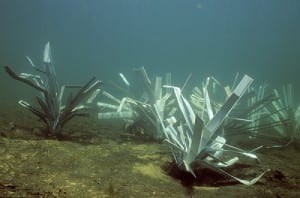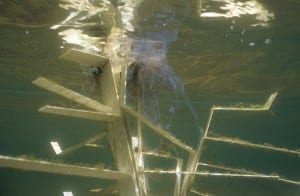UNDERWATER RE-EVOLUTION
By Larry D. Hodge
A revolution is brewing among biologists managing freshwater fisheries in reservoirs. Or, put another way, a
re-evolution of fisheries management is taking root.
See the dozens of unique artificial fish habitat models, fish attractors and fish cover used at fishiding.com, the leader in science based, proven, fish protection.
Rather than applying a top-down approach to fisheries management by stocking fish, biologists are going bottom-up by stocking plants and putting in fish attractors to create habitat, sort of an “if we build it, they will come” approach. The movement to improve fish habitat in reservoirs falls on particularly fertile ground in Texas, where hundreds of constructed reservoirs dominate the landscape in a state that has only one natural lake of significant size but more inland water than any other state (except Alaska).
Dave Terre, chief of research and management for the Texas Parks and Wildlife Department’s Inland Fisheries Division, is a leader in the nationwide movement to improve fish habitat in reservoirs.
“About four years ago people from state wildlife agencies across the United States had the idea of creating a habitat partnership focused on reservoirs,” he explains. “That movement became the Reservoir Fisheries Habitat Partnership (RFHP). The goal is to improve fish habitat in reservoir systems, including the river above and the tailrace below, recognizing that you can’t always just do something in the reservoir and expect a positive change.”
Reservoirs are unnatural systems, often lacking in native aquatic plants. Damming a stream and flooding the terrestrial habitat around it creates a bizarre submerged waterscape of dead trees, brush, old roadbeds and whatever else was built on the land. Decaying vegetation releases nutrients into the water that jump-start the fishery and maintain it for a time, but reservoir fisheries typically decline over time as the flooded vegetation degrades. Stocking fish into this alien world creates a fishery, but one not likely to be sustainable or able to reach its full potential.
The importance of plants in reservoirs is difficult to overstate.
“The function of plants is to capture sunlight and turn it into food,” says Richard Ott, a fisheries biologist for the Texas Parks and Wildlife Department. “Everything starts with aquatic plants. Some are food for fish directly, but more importantly, they are also food for insects and invertebrates that are eaten by small fish that are eaten by big fish and then by us. Plants provide cover for small fish to hide in and grow. They generate oxygen, buffer changes in pH, slow wave action and filter water.”
Plants do much more for reservoirs, their watersheds and the people who live there than just provide for the needs of fish.
“Tying down the shoreline and reservoir bottom with native vegetation reduces erosion and the amount of suspended sediment in the water,” TPWD fisheries biologist Mark Webb points out. “Because plants are taking nutrients out of the water, algal growth is reduced, which helps improve the quality of drinking water. Once well-established, native plants give a great amount of benefit for low cost.”
Native plants also help fight invasive nonnative species such as hydrilla.
“We try to fill a niche,” says Ott. “If you have a bare piece of ground and want to keep it that way, you have to be doing something all the time to kill stuff trying to fill that open niche. If we can fill that niche with native species, it makes it harder for exotic species to get established. Waterfront property owners may object to having any plants, but they should understand that plants outside a bulkhead area dissipate wave energy, which means they don’t have to replace expensive bulkheads as often. Once they see native plants as being a lesser evil than exotic species, they get on our side.”
Partnerships are key to the effort.
“Funding these projects is a huge problem for many states,” Terre observes. “The only way we can do that is through partners. We created a 501(c)3 corporation, Friends of Reservoirs, to be the financial arm of the RFHP. We are reaching out to organizations such as bass clubs, watershed groups, homeowners associations, individuals — anybody who is interested in improving fish habitat to benefit water quality, fish and the quality of life of the American people.”
Ott and Webb have been in the forefront of efforts to introduce native aquatic plants into Texas reservoirs, following the lead of the U.S. Army Corps of Engineers’ Michael Smart, head of the Lewisville Aquatic Ecosystem Research Facility.
“When Dr. Smart suggested that we should stock native aquatic plants for the same reasons we stock fish, we wanted to kick ourselves for not having seen the obvious,” Ott smiles. “You have to ask yourself when you stock fish: Where will they live and what will they eat?
“There are aquatic plants native to Texas that will survive in reservoirs,” he continues. “These plants lived in wetland areas and backwaters of streams. But you can’t plant them just anywhere. In reservoirs you have to deal with fluctuations in water levels. Plants have to be matched to the water depth and clarity they need. They have to get sufficient sunlight to grow, but they can’t be planted so shallow they will be dry at the times they need to be growing.”
Using plants from Smart’s Lewisville facility, Webb and Ott experimented on seven Texas reservoirs that represent a cross-section of conditions across the state to develop a list of native Texas plants that will survive under a variety of conditions. They also experimented with techniques to aid survival of these plants under reservoir conditions different from those of natural lakes.
Like Smart, they decided that a founder-colony approach works best. Plants are raised in a nursery in plastic pots before being transplanted to a reservoir, where they are enclosed in a wire cage to prevent being eaten by turtles, fish or land-based herbivores. Over time the plants spread outside the cages.
After this first phase, biologist made plantings in Lake Bellwood, a former water-supply lake for the city of Tyler, to demonstrate what they had learned.
Stocking plants in reservoirs throughout Texas presents a tremendous challenge. The first hurdle to overcome is establishing a reliable and affordable supply of plants. Nursery facilities have been set up at the Texas Freshwater Fisheries Center in Athens, at the Lake Waco wetlands and on San Jacinto River Authority (SJRA) property at Lake Conroe. The latter furnishes the model for how the Friends of Reservoirs process is envisioned to work.
“The Seven Coves Bass Club on Lake Conroe has been one of our major partners,” Webb says. “Seven Coves members approached me to ask about stocking fish, and I steered them toward native vegetation. It was not a tough sell. They are really conservation-minded. I explained that the lake has good water quality, good nutrients and good spawning areas, but it did not have good habitat for small fish to hide in. Club members saw we had a huge increase in our bass production after we planted some shoreline vegetation, and they really got excited.”
Former Seven Coves President Ron Gunter recalls: “We got a grant through the U.S. Fish and Wildlife Foundation that let us create a native aquatic plant nursery at the SJRA Lake Conroe property. The SJRA donated the land. We purchased the construction materials and built raceways for the nursery and got plants from the Lewisville Aquatic Ecosystem Research Facility. We put half the first shipment of plants in the lake and kept the second half for seed stock.”
Involvement with the project brought public exposure that helped increase Seven Coves membership from 17 people in 2005 to nearly 70 at present. Seven Coves Bass Club is now the first organization in the nation to be granted chapter membership in the Friends of Reservoirs.
“We intend to continue with the native plant restoration project in hopes we can sustain what we consider to be an excellent fishery in Lake Conroe,” Gunter says. “The payoff is knowing that we’ve done something that can make a change for future generations. We’re not looking for immediate dividends; we’re trying to make it possible for our children and grandchildren to enjoy Lake Conroe like we’ve been able to.”
Other projects carried out by the Seven Coves Bass Club include a grass carp removal tournament with the assistance of the Texas Bow Anglers Association, the installation of more than 700 cinder-block-and-bamboo fish attractors and the introduction of native plants along miles of shoreline.
The fish attractors and the plants are two sides of the same coin. “The spider blocks are the temporary habitat; the aquatic plants will be the permanent habitat,” Gunter says.
Funding projects through the Friends of Reservoirs allows local groups to raise money under the organization’s 501(c)3 umbrella, making it easier to attract corporate donors. All funds raised by a group are earmarked for the group’s projects and are not shared with anyone else, which helps maintain local control.
“The Friends of Reservoirs is a great deal in that regard,” says Gunter. “Check it out and then get out and beat the bushes for funds.”
It’s often said that “what happens in Vegas stays in Vegas,” but with water, what happens in a watershed ends up in a reservoir. Friends of Reservoirs projects will coordinate programs targeting land management practices in watersheds to improve the quality and quantity of runoff into reservoirs.
“Re-establishing native vegetation in Lake Conroe will have some beneficial effect from the standpoint of water quality,” says SJRA Lake Conroe division manager Blake Kellum, “but primarily what we recognize is benefit to the ecology of the reservoir. We view ourselves as stewards of the reservoir and want to take a balanced approach to the management of that resource. We are trying to put as much effort into native plant restoration as we did trying to control invasive species on the front side.”
It’s a team effort. “Scaling up for big projects will require more equipment and labor,” says Ott. “That’s where volunteer groups can really help out. If a group wants to take on a project, we have the expertise and the plants. If they can provide the people, it becomes fairly simple. Historically, that’s how we’ve manipulated fish populations, by regulations directing harvest to the size fish we need to have removed. All along, anglers have been the ones pulling the plow while we walk along behind directing where the plow should go.”
The Friends of Reservoirs program makes it possible for everyone interested in a lake to help pull the plow. Anglers, boaters, area property and business owners, water utilities and consumers and anyone involved in water-based industries will benefit from improved water quality, control of invasive aquatic species and reduced maintenance and operation costs from lower rates of erosion and sedimentation.
“There are already lots of groups out there working with their fisheries biologists planting native vegetation or placing brush piles,” Terre says. “All of those could be a Friends of Reservoirs chapter. This is not a governmental organization, but rather partners from across the United States who are interested in improving fish habitat. Reservoir partnerships are the way all those people will connect to work with each other. I really believe we can make a difference.”
Related stories
Demands on Lakes Rising; Now’s the Time to Address Water Needs
Invasive Species Advance; Bugs Battle Back
Growing Fish Food





